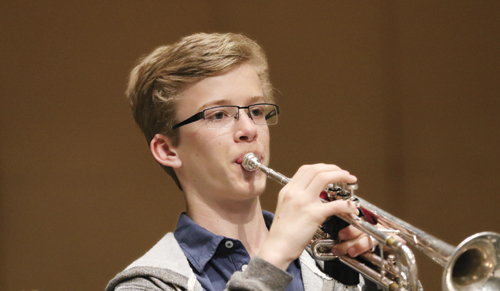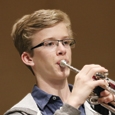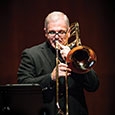
Most ensemble directors begin rehearsals with a warmup routine for good reason: every musician benefits from a daily routine that addresses the fundamental aspects of music making in a systematic manner. For brass players, such a routine is essential. Brass players are the only musicians for whom the source of vibration is a part of the body not used in a similar manner in any other activity. Inefficient, improper, and even harmful usage of those otherwise little-exercised muscles can occur if they are not adequately prepared for strenuous playing. An effective series of exercises also establishes the mindset necessary for correct playing and emphasizes good playing habits. While warmup routines used by different teachers and programs will vary, the most effective routines are comprehensive and efficient, delivering great results while occupying relatively little rehearsal time.
Contents of an Effective Routine
There are many appropriate and effective routines. Indeed, a thoughtful teacher will tailor exercises to the needs of a given student or ensemble. Still, there are certain features are present in every effective brass warmup, at every level. These include:
Breathing exercises. Every brass warmup, whether in individual or ensemble practice, should begin with a few exercises from The Breathing Gym or some similar program. Low brass players will be particularly aware of the benefits of beginning by moving large quantities of air in a robust yet relaxed manner, but all wind instrument players will reap benefits from these exercises.
Mouthpiece buzzing. A bit of mouthpiece daily buzzing promotes good pitch and helps to eliminate inefficiencies in student embouchures. Have students buzz simple exercises or familiar tunes, always using a pitch reference so students are hear and reproduce pitches accurately. Overuse of mouthpiece buzzing can sometimes be harmful, so limit buzzing to just one or two exercises or tunes during the rehearsal, at least at the beginner level.
Long tones. Conscientious practice of long tones enables the player to work on the inhalation, attack, tone quality, intonation, dynamic level, and release of each note. Timing of these elements is crucial in these exercises, as is the pursuit of a strong, vibrant sound.
Lip slurs. These exercises build strength and flexibility in the embouchure. Start beginning students with descending slurs; ascending lip slurs are more difficult and should be added a few weeks or months later. With all slurring, teach students to blow a constant stream of air and use changes of vowel shapes (oh, ah, ee, etc.) to produce note changes during lip slurs.
Range extension. Have students systematically test the outer limits of their ranges each day through assigned exercises. The use of vowel shapes as mentioned above is important here. Developing the physical capacities to play high and low is often challenging, but it need not be complicated. Still, the teacher must be vigilant in addressing particularly harmful habits, such as excessive mouthpiece pressure.
Articulation. At the beginning level articulation exercises serve to promote correct technique more than to build speed. Simply hearing the teacher say tah or dah during a brief tonguing exercise can guard against the tendencies of some students to use a pah attack, breath attack, or some other improper technique. As students develop, faster tempos and multiple-tonguing can be introduced, as well as legato tonguing and other refinements. Articulation exercises can also be used to introduce and rehearse scales.
While the above might sound like quite a bit of material, once the students learn the exercises well, a routine addressing all of these areas can be completed in 5-10 minutes. This is enough time for a thorough warmup for beginning students, as well as a routine sufficient to prepare older students’ embouchures and bodies for the needs of a band rehearsal. Advanced students will benefit from additional time spent on such exercises outside of the ensemble setting, though the exercises in their longer routines will likely still fall within the above categories.
Getting Started
While some teachers do not teach a dedicated warmup routine until weeks or months into the first year of playing, I advocate introducing a routine by rote during the first few days of students’ playing careers. Many educators dislike rote memorization, and students certainly need to learn to play well at sight. However, the occasional and judicious use of rote teaching can be effective, and this is one such instance. Here are a few reasons for this.
Embouchure development. Having a comprehensive daily warmup routine is good for students’ development and need not be delayed until students’ reading ability improves.
Range maintenance. Sometimes while choosing instruments students will unknowingly execute a large playing range on what will be their chosen instruments, only to have that range reduced after seeing the limited number of notes used in the early pages of every band method. Their limited knowledge of written notes and fingerings shrinks the parameters of what students subconsciously regard as possible, and some initial skill is lost. Assuming that students have been placed on appropriate instruments and embouchure formation is adequately explained, there is no reason why beginning brass players cannot cover an octave or even a bit more on the first day, and then extend that range through imitation and repetition before their reading ability catches up.
Finding fingerings and positions. The typical beginning band method does not cover all of the fingering possibilities or slide positions in the first year, saving fifth and seventh positions (and their corresponding fingerings) for the second year. Finding those positions might be less daunting task for trombonists if they are introduced and regularly reviewed from the beginning (granted, reaching a true seventh position is often impossible for young beginners). Even valved instrument players will benefit from learning all of the chromatic fingering possibilities from the first day.
Ear training. When playing exercises by rote students have to listen to and mimic the sound being played or sung by the teacher. This develops the connection between the ear and the embouchure which is so vital to musical success.
Ease of introducing new written notes. When warmup exercises are learned this way, students start out playing most of the notes that will be introduced in the first and second year method books. Thus, when a new written note is encountered, the teacher can indicate that students have already been playing that note in the daily routine, and much difficulty with mastering it is eliminated. To put it more briefly, students’ playing ability should stay ahead of their reading ability.
Warming Up in Rehearsals
Incorporating a warmup that will help brass players in the full band rehearsal can be tricky, as the needs and capabilities of brass, woodwind, and percussion students will differ. This is particularly true at the beginner level. While long tone and lip-slur exercises using all of the available fingerings or slide positions can be introduced to brass players during the first few days of playing, it will be some time before woodwind players will learn the fingerings needed to play the same exercises in unison with the brasses. Besides, woodwind and percussion students have their own needs to address.
These incompatibilities are one reason that I advocate separating brass, woodwind, and percussion sections in beginner band classes whenever possible. Directors can then use daily fundamental routines that are appropriate for each instrument family. Full band rehearsals will still be necessary, particularly when preparing for a concert. When students have played with only one family of instruments at a time, playing with the full ensemble becomes a real treat.
Again, the warmup routine for beginners, once learned, should take no more than 5- 10 minutes of rehearsal. Remember that the objectives are to promote healthy embouchure development and correct playing techniques, not to exhaust students before even looking at etudes and concert music. In this vein the requirements of horn players are worthy of special consideration. Because its fundamental pitch is F rather than Bb, the horn’s middle register does not align with those of the other brasses. Having young hornists play unison fundamental exercises with the rest of the class will often result in them playing higher or lower than is comfortable, and lip-slur exercises usually cannot be executed without changing fingerings on each note, an unhelpful complication. For this reason, I advocate having the warmup routine for horn written with the sounding pitch a fifth off from the rest of the brasses (i.e. the horns will play concert F while the rest of the group plays concert Bb). This will enable hornists to warm up in a comfortable range without moving fingers during the lip-slur exercises, and a large number of the fingerings for the horn routine will be the same as those on the other valved instruments. Some beginning band method books now take a similar approach with horns, at least in the early weeks and months of playing, so the idea should be familiar.
The amount of time spent on fundamental exercises should increase as students develop, but the amount of rehearsal time devoted to them might not change. By high school students should be able to perform maintenance work on their own, though devoting a bit of rehearsal time each day to such exercises gives the director an opportunity to check for correct technique and ensures that all players get some healthy daily fundamentals work. At this level woodwind students should be able to play along with the brass section’s daily exercises, so a daily routine for full band can be constructed that serves the entire group reasonably well. Directors who check student pitch using an electronic tuner should wait until after the warmup is completed, as the pitch is unlikely to settle in before embouchures have been exercised a bit. Daily use of a brief but comprehensive warmup routine enables young brass players to develop strong and efficient embouchures while also cultivating correct playing techniques and accurate aural perception.






